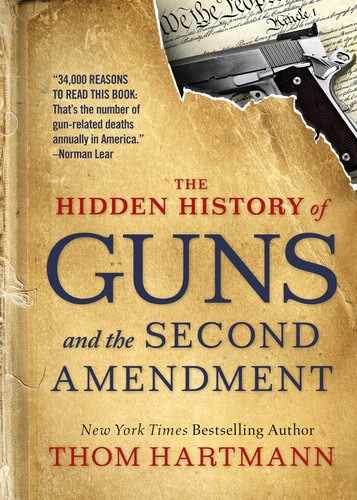CHAPTER 20
Guns, Militarism, and the War on Drugs
The War on Drugs employs millions—politicians, bureaucrats, policemen, and now the military—that probably couldn’t find a place for their dubious talents in a free market, unless they were to sell pencils from a tin cup on street corners.
-Science-fiction author and political activist L. Neil Smith
In 2012, a Kansas SWAT team carrying weapons of war worthy of an operation against ISIS raided the home of Robert and Addie Harte and tore their house apart looking for evidence of a major marijuana-growing operation.
The investigation began when a state trooper stationed at a gardening supply store (yes, they had the gardening store staked out!) spotted Robert Harte and his son purchasing supplies to grow hydroponic tomatoes.
According to the Washington Post, having seen the Hartes buying hydroponic growing accessories, the Johnson County Sheriff’s Department started investigating the Harte family.1
They searched the family’s trash and found “saturated plant material” that supposedly tested positive for THC, the active chemical in marijuana.
But in reality, Mrs. Harte is a tea drinker, and that wet plant matter was nothing more than used tea leaves; the SWAT raid, when the wet tea was retested, had turned up nothing.
The family sued for false arrest and intimidation, but a federal judge dismissed the family’s lawsuit against the police, saying that the sheriffs had probable cause based on the garden store purchase and old tea leaves.
But the Hartes aren’t the average targets of this kind of drug sting, and one sheriff actually boasted after the raid that the operation was so unusual because they’d shut down a drug operation that was run by an “average family” in a “good neighborhood,” all coded language for “middle-class white people.”
Aside from the fact that the Hartes weren’t actually doing anything illegal, the sheriff unwittingly showed just how exceptional it was that the family was a target at all.
Because the war on drugs has never been about drugs.
The war on drugs, since Richard Nixon declared it, has been about controlling political power by breaking up black communities and the dissident left. The people who were involved, the architects and the leaders in the war on drugs, admitted it and even bragged about it.
Before he died, Nixon counsel and former assistant to the president John Ehrlichman told author Dan Baum,
The Nixon campaign in 1968, and the Nixon White House after that, had two enemies: the antiwar left and black people. You understand what I’m saying? We knew we couldn’t make it illegal to be either against the war or black, but by getting the public to associate the hippies with marijuana and blacks with heroin, and then criminalizing both heavily, we could disrupt those communities. We could arrest their leaders, raid their homes, break up their meetings and vilify them night after night on the evening news. Did we know we were lying about the drugs? Of course we did.2
The Nixon administration signed the Controlled Substances Act into law in 1970, officially codifying the war on drugs into federal law, and then used the war on drugs to help politically (and often physically) assassinate community leaders, and to fracture communities by removing individuals from society and throwing them in prison.
By 1973, more than 300,000 people were being arrested every year under the law, and a disproportionate number of those were African-Americans.
The plan went hand in hand with the Republican southern strategy, as former Republican strategist Lee Atwater described.3
Nixon and his advisers weren’t the first to invent and promote a racist war on drugs, though, and use the armed power of the state to destroy US citizens’ lives. Using drug enforcement as a way to oppress minority communities already had a 40-year precedent.
In the 1930s, Harry J. Anslinger served as the first commissioner of the US Treasury Department’s Federal Bureau of Narcotics, which eventually became the Drug Enforcement Agency. Back then, he reportedly claimed, “There are 100,000 total marijuana smokers in the US, and most are Negroes, Hispanics, Filipinos and entertainers. Their Satanic music, jazz and swing result from marijuana use. This marijuana causes white women to seek sexual relations with Negroes, entertainers and any others.”4
He also used explicit racist epithets in his diatribes, saying, “Reefer makes darkies think they’re as good as white men.”
The language had become subtler by the 1970s, but the ideas were the same.
According to the Justice Policy Institute, approximately 500,000 people were serving time for drug offenses in state and federal prisons and jails in 2008.5 Unsurprisingly, the NAACP reports that 38 percent of people arrested for drug offenses are black, and 59 percent of drug offenders in state prisons are African-American (while blacks represent about 17 percent of the population).6
The war on drugs costs America tens of billions in federal and state tax dollars every year, and the only result has been millions of undue criminal convictions that have ruined lives, destroyed communities, and undermined democracy.7
Today, the genocide of Native Americans has settled into a slow simmer of malnutrition, poverty, and voter suppression; the enslavement of people of African descent has shifted from plantations to slums and prisons; and the modern police state constructed during the conquest era, the slavery era, and Reconstruction after the Civil War, and thrown into high gear in the 1970s with Nixon’s war on drugs, is still alive and well.
All it requires to keep it in place is lots of guns.
